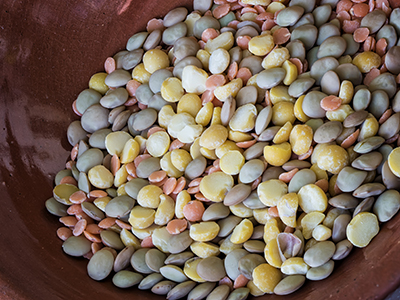In the International Year of Pulses, scientists are aiming to double the area in Queensland’s tropics and subtropics sown to these healthy, and often very profitable, legume crops.

Grain growers and researchers have increasingly come to understand the valuable role that legumes can play in crop rotations, and a continued run of record high prices in recent years, particularly for mungbeans and chickpeas, have pushed their popularity even higher.
This increasing demand for productive pulse varieties and information on how to manage them has added urgency to the research effort, which historically has been done in a somewhat piecemeal way.
The GRDC-funded Queensland Pulse Agronomy Initiative, conducted by QAAFI in collaboration with DAF, NSW DPI, Pulse Australia and the Peanut Company of Australia (PCA), is seeking to increase the reliability and yield of summer and winter pulses. The work takes a whole-systems approach, examining the interactions between genetics and agronomy. It has had considerable success to date in identifying narrow row spacing and other management practices – all of which have contributed to a bumper crop this past summer.
Professor Graeme Hammer, Director of QAAFI’s Centre for Plant Science, says the team is now looking to take that work to the next level. “We want to look at how we intensify the use of legumes in northern systems, because they provide so many benefits: disease breaks, weed control, nitrogen fixation – a range of system-level improvements.”
Leading the current project is Dr Rao (RCN) Rachaputi, Senior Research Fellow in QAAFI’s Centre for Plant Science. Dr Rachaputi’s project is concentrating on five major pulse crops: chickpeas and faba beans (winter) and mungbean, soybean and peanut (summer).
“It’s a state-wide project and we are doing both summer trials and winter trials,” Dr Rachaputi says. “For all of the crops tested, we have solid data that shows the current recommendation for plant populations, such as 30 plants per metre square, are in fact delivering the best yields. However for row spacing, we have found narrow rows are achieving higher yields than wide rows.”
Dr Rachaputi adds that more work is needed on mungbeans, where the row spacing recommendations have worked in Southern, but not Central Queensland.
“I think there could be a couple of reasons for this,” he says. “The first relates to varietal adaptation: maybe the varieties produced here are not suited for Central Queensland. The second reason is late sowing. We found that the crops planted beyond January, even on a full moisture profile, produced poor yield. This is mainly due to low minimum temperatures starting from February, which affect reproductive growth and development of mungbean. So early planting in December at full moisture profile is actually more productive.”
Even though earlier sowing results in higher plant biomass, converting this biomass into yield remains problematic, particularly in chickpeas, and Dr Rachaputi is keen to understand why.
“We seem to have a yield ceiling with our existing chickpea varieties, producing a maximum of four tonnes per hectare irrespective of the amount of biomass produced,” he says. “Why is this? We don’t know, but we’d like to test some of our theories: how can we make plants partition more by planting early?”
In addition to improving the performance of established pulse crops, Professor Hammer says there is a need to look outside the square for additional legume options for northern systems. “There is some more basic physiology research we could do to understand legumes better, and to try to figure out what would be the best types to bring in, and how best to fit them into a plausible crop rotation system.”
Because legumes comprise a substantially smaller share of the cropping area and market share than cereals in Australia, to date there has not been the same level of investment in research. However Professor Hammer says the collaborative nature of the Pulse Agronomy Initiative will allow them understand the true potential role of legumes in northern cropping systems.
“The skill base we bring together is around genetics and breeding, physiology and modelling, and agronomy,” he says. “We use modern genetics, information technologies and computational systems to get the best out of our crops.”
“In legumes, we haven’t had the same level of resources as we have in cereals. But we get that through collaboration with GRDC, DAF and others,” he says. “Through this work, we can ultimately move beyond knowing just how to grow mungbean and chickpea to understanding how to best intensify the use of legumes in our cropping systems.”



